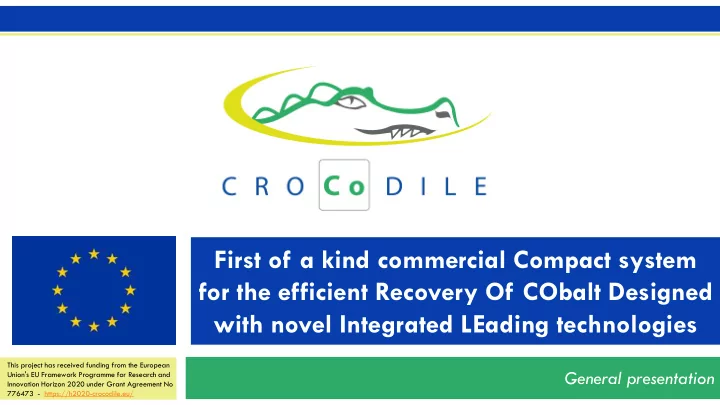

First of a kind commercial Compact system for the efficient Recovery Of CObalt Designed with novel Integrated LEading technologies This project has received funding from the European General presentation Union's EU Framework Programme for Research and Innovation Horizon 2020 under Grant Agreement No 776473 - https://h2020-crocodile.eu/
Outline 2 Why cobalt? Supply, demand & use of cobalt Importance of cobalt recovery for the EU Economy The Crocodile project: its aim, activities and expected benefits
Why cobalt? 3 = Critical Raw Material (CRM) Exceptional high-temperature strength, corrosion- resistance, catalytic properties, Exceptional strengths for electrochemical properties: crucial element for high performance https://cosmosmagazine.com/technology/how-does-a-jet-engine-work applications (e.g. jet engines and electrical power generation turbines, high strength steel, super alloys, samarium cobalt magnets, catalysts, pigments, tires, etc.). Increasing demand http://wtamu.edu/~cbaird/sq/2013/03/26/how-do-magnets-heal/
Supply, demand & use of cobalt 4 Rising demand, deficit and price: Cobalt (kt) 250% increase in price over one year Demand for cobalt is expected to soar with the growth of LIB, particularly EV batteries Large deficit in cobalt supply and demand is expected Cobalt price increased by ~ 250% in 2017- between Source: CANACCORD Genuity report, May 2018 in the coming few years. Source: Exane BNP Paribas the submission and approval of CROCODILE! Batteries: about 50% of the overall current cobalt demand worldwide (estimated at more than100k ton annually) is related to the production of lithium-ion battery (LIB) cathodes. By 2020, the cobalt demand in battery applications alone could be greater than the entire world market for refined cobalt in 2015. Cobalt price has risen nearly 250% in the 2017 and is expected to significantly increase in the coming years, driven by stricter emissions controls that push global demand for electric vehicles.
Importance of cobalt recovery for the EU Economy 5 Supply risk! Primary production = 65% (approx. 10,000 tons/year). = Imported from geopolitically unstable countries such as Democratic Republic of the Congo (DRC), Zambia or Central African Republic. Secondary production = 35%. = Mainly from recovered from spent batteries, superalloys and hard metals.
The Crocodile project 6 First of a kind commercial Compact system for the efficient Recovery Of CObalt Designed with novel Integrated LEading technologies http://h2020-crocodile.eu/ Solution: Challenge: Provide a zero-waste strategy for Improve the economic and environmental important waste streams rich in cobalt values of recovery processes of cobalt in such as batteries. Europe. CROCODILE Funding & Duration: Targeted feedstocks: Horizon 2020 - Grant Agreement No. The targeted primary and secondary raw 776473- EC contribution: 11 625 289€ materials are laterite mines, autocatalysts 4 years: from June 2018 to May 2022 and batteries.
The Crocodile objectives 7 Demonstrate scaled-up innovative ➢ integrated systems and technologies capable of enhancing the efficiency of existing raw materials recovery processes; DES Leaching reactor at Tecnalia (left), Bioleaching experiments with COG3 samples conducted by COG3 Develop a new mobile system with the ➢ partner Acidophile Research Team at Bangor University (center) and the EcoRecycling mobile plant (right) capability of producing cobalt metal to enable new business opportunities and expand the business across the EU; Build a strong value chain capable of ➢ supplying approx. 10,000 ton of cobalt per year (about 65% of the current EU demand) from mainly European resources. CROCODILE mobile solution overview
The Crocodile consortium 8
The Crocodile consortium 9
The Crocodile project 10
The Crocodile project activities (1/2) 11 Build a commercial compact mobile system with a capacity of up to 200kg of cobalt metal per day-65ton/year; Optimise the pretreatment step of secondary waste rich in cobalt by advanced mechanical, wet mechanical process and pyrometallurgy; Fine-tune the recovery process, from economic and environmental point of view, designed in a closed-loop set up, reducing OPEX and waste generation.
The Crocodile project activities (2/2) 12 Scale up the bio-processing route for primary resources; Develop a detailed market analysis and business models based on process efficiency, metal stock exchange and market share, and an engagement strategy with investors; Engage with civil society to obtain a social license to operate and to co- develop the CROCODILE solution.
Life Cycle Assessment 13 A methodology that takes into account the health, safety and environmental risks. Addressing REACH, RoHS and local environmental standards. Modelling of the pilot unit and design. Economic and environmental assessment of the pilot unit.
Material Flow Analysis 14 Environme Environmen Environment ntal tal stressors statistics Market Economic and Economics supply & trade demand data Environme ntal Security Societal policy and Supply instrument s
Stakeholder involvement 15 Stakeholder analysis Key players = a.o. local communities Locals events: discuss Social License to Operate (SLO). Two-way communication starts with listening… High-level multi-stakeholder transition arena
The Crocodile project benefits 16 Reduce drastically the supply risk of cobalt for the European industry Lower energy costs and environmental impacts Providing solutions with low capital investment costs Maximize the exploitation of the local waste.
17 Contact TECNALIA Dr. Amal Siriwardana (Project Coordinator) Amal.Siriwardana@tecnalia.com http://h2020-crocodile.eu/ CROCODILE is a project funded by the European Commission. This project has received funding from the European Union's Horizon 2020 Research and Innovation program under Grant Agreement n° 776473
Recommend
More recommend